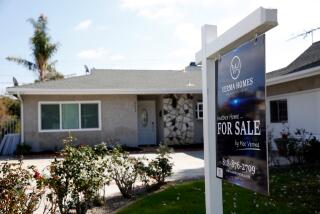Home prices notch third straight monthly gain
With an uptick in June, home prices in major U.S. cities have recorded three consecutive months of gains. But the glimmer of improvement is almost certainly seasonal in nature, real estate experts said, and prices could begin to fall again when the slower sales season begins.
The Standard & Poor’s/Case-Shiller index of home prices in 20 metropolitan areas rose 1.1% from May to June when left unadjusted for seasonal variations. Prices fell 4.5% from June 2010.
Prices often increase in the warmer months because of changes in the types of homes selling, particularly in parts of the country that have harsher weather than Southern California. Foreclosures make up a higher proportion of sales during the winter as families take a break from home shopping and cash-rich investors dominate the market. Higher sales volumes in spring and summer also push up prices.
“A seasonal kick accounts for the recent strength in the indexes,” Patrick Newport, a U.S. economist with IHS Global Insight, wrote in a note to clients. “This kick will wear off in the fall, when demand weakens and sellers have to give way on price, and prices will start dropping again.”
The Case-Shiller index also includes data that is adjusted for seasonal variations, but the experts who publish these numbers have cautioned that the large number of foreclosures on the market have distorted the statistics.
There were some signs of hope.
None of the cities tracked by the index posted new lows. In March, home prices dipped below their recession-era low of April 2009, confirming a much-expected double-dip in home prices, but that was short lived as the selling season pushed prices back above that mark.
Many experts, however, say that the level of job creation needed for steady home price gains is still elusive. For prices to make sustained gains, the market needs a steady supply of buyers and sellers. Holding people back from making purchases, experts say, are factors such as unemployment and the difficulties that people with less-than-stellar credit have getting mortgages.
In addition, the decline in home equity brought on by the bust has discouraged move-up buyers, a traditional source of housing-market oomph.
Although foreclosures have slowed, repossessed properties continue to represent an unusually large proportion of home sales, and those houses tend to drag prices down. The number of foreclosures could increase again if the economy worsens and if banks pick up the pace after working through negotiations with regulators over their repossession practices.
Nineteen of the 20 regions measured by the Case-Shiller index were up in June over May, according to the data released Tuesday. Eight cities remain above their April 2009 bottom, including all of the metro areas in California: San Diego, San Francisco and the Los Angeles region, which also covers Orange County.
Home prices in the California cities are considered relatively healthy, despite the state’s high unemployment rate, because they are markets that are close to job centers and near the ocean — where overbuilding was relatively constrained and demand remains healthy. The index does not track prices in California’s Central Valley or the Inland Empire, where housing is still weak.
“These shifts suggest that we are back to regional housing markets, rather than a national housing market where everything rose and fell together,” David M. Blitzer, chairman of the index committee at Standard & Poor’s, said in a statement.
Recent turmoil in the nation’s stock markets also has shaken the faith of consumers in the future of the U.S. economy. A separate economic gauge released Tuesday underscored this fear. That measure of consumer sentiment dropped to its lowest level in more than two years.
The Conference Board’s consumer confidence index now stands at 44.5, down from 59.2 in July, a drop of nearly 15 points. The last time the index was near this low was in April 2009, just after the financial crisis had sent markets into a free-fall that had ended that March, when it stood at 40.8.
The group’s present-situation index, which tracks how people feel about the current state of the economy, fell to 33.3 from 35.7. The big decline came in people’s views about the future of the economy, with the expectations index dropping to 51.9 from 74.9 last month.
Ian Shepherdson, chief U.S. economist for High Frequency Economics, said that consumer confidence should improve now that the gyrations of the stock markets have eased.
“The expectations number is always sensitive to stock prices, so it should now stabilize if the market remains close to current levels,” he wrote in a note Tuesday.






